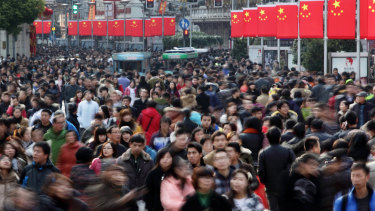China’s revival is propping up the global economy
China’s economy is back-ish and the world can exhale. Without this rebound, the nascent global recovery would be on even thinner ice.
The expansion reported is close to the numbers China chalked up before COVID-19 tore through national and global commerce. Gross domestic product rose 4.9 per cent in the third quarter from a year earlier. While that’s less than economists expected, it was an acceleration from 3.2 per cent in the previous three months. The contraction of 6.8 per cent between January and March, terrible as it was, is fading in the rearview mirror.

The numbers underscore projections last week from the International Monetary Fund that China will be the only major economy to advance in 2020. Absent such momentum, any prediction that the world is poised to resume growth next year would be fanciful.
The IMF’s forecast of a 5.2 per cent expansion is heavily dependent on Beijing not making mistakes and avoiding another sweeping shutdown. The brawny nature of the comeback buttresses struggling countries in China’s regional orbit; one bright spot in Singapore’s otherwise challenging economic performance is exports to the mainland.
Given all these nice numbers, is it possible that China could be pulling off that hallowed V-shaped recovery? Factories are humming, exports are up and property sales in big cities exceed pre-COVID levels. After a slow start, rising consumer confidence is finally beginning to translate into higher spending. Retail sales jumped 3.3 per cent in September from a year earlier, a separate report Monday showed. Any drop-off would leave China’s revival lopsided and more exposed to exports. That’s a dicey prospect when recoveries in the US, Europe and Japan are proceeding with caution. Another qualifier is the role that China’s authoritarian political system played in locking down nationwide activity hard and early. The government also pursued reopening aggressively.
While the US is often derided abroad for prevaricating on masks, squabbling about fiscal stimulus and its thicket of national and local politics, democracy is never going to be perfect. The US remains the world’s largest economy, which has deployed a significant pile of assets to the globe’s benefit. The Federal Reserve led major central banks in flooding the financial system with liquidity, shoring up markets and unleashing a raft of special lending facilities. The Fed’s dollar swap programs with counterparts in the West and some important emerging markets eased a troubling shortage of greenbacks.
Important as China’s steps to stimulate its economy have been, they don’t come close to packing the same punch.
In fact, the People’s Bank of China has been pretty neutral, a considerable factor behind the yuan’s appreciation. The PBOC’s relative discretion is partly thanks to the stability the Fed brought to markets.
This comeback is welcome, and with it, the repudiation of skeptics who asserted Beijing had finally met its match with the virus. Yes, COVID-19 taught us that its four-decade expansion wasn’t infallible. China’s economy is mortal. Long live China’s recovery.
Daniel Moss is a Bloomberg Opinion columnist covering Asian economies. Previously he was executive editor of Bloomberg News for global economics, and has led teams in Asia, Europe and North America.
Bloomberg
Market Recap
A concise wrap of the day on the markets, breaking business news and expert opinion delivered to your inbox each afternoon. Sign up for the Herald‘s here and The Age‘s here.
Most Viewed in Business
Source: Thanks smh.com